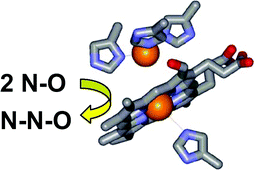Spectroscopic characterization of heme iron–nitrosyl species and their role in NO reductase mechanisms in diiron proteins†
Abstract
Covering: up to November 2006
Nitric oxide (NO) plays an important role in cell signalling and in the mammalian immune response to infection. On its own, NO is a relatively inert radical, and when it is used as a signalling molecule, its concentration remains within the picomolar range. However, at infection sites, the NO concentration can reach the micromolar range, and reactions with other radical species and transition metals lead to a broad toxicity. Under aerobic conditions, microorganisms cope with this nitrosative stress by oxidizing NO to nitrate (NO3−). Microbial hemoglobins play an essential role in this NO-detoxifying process. Under anaerobic conditions, detoxification occurs via a 2-electron reduction of two NO molecules to N2O. In many bacteria and archaea, this NO-reductase reaction is catalyzed by diiron proteins. Despite the importance of this reaction in providing microorganisms with a resistance to the mammalian immune response, its mechanism remains ill-defined. Because NO is an obligatory intermediate of the denitrification pathway, respiratory NO reductases also provide resistance to toxic concentrations of NO. This family of enzymes is the focus of this review. Respiratory NO reductases are integral membrane protein complexes that contain a norB subunit evolutionarily related to subunit I of cytochrome c oxidase (CcO). NorB anchors one high-spin heme b3 and one non-heme iron known as FeB, i.e., analogous to CuB in CcO. A second group of diiron proteins with NO-reductase activity is comprised of the large family of soluble flavoprotein A found in strict and facultative anaerobic bacteria and archaea. These soluble detoxifying NO reductases contain a non-heme diiron cluster with a Fe–Fe distance of 3.4 Å and are only briefly mentioned here as a promising field of research. This article describes possible mechanisms of NO reduction to N2O in denitrifying NO-reductase (NOR) proteins and critically reviews recent experimental results. Relevant theoretical model calculations and spectroscopic studies of the NO-reductase reaction in heme/copper terminal oxidases are also overviewed.

- This article is part of the themed collection: Heme

 Please wait while we load your content...
Please wait while we load your content...